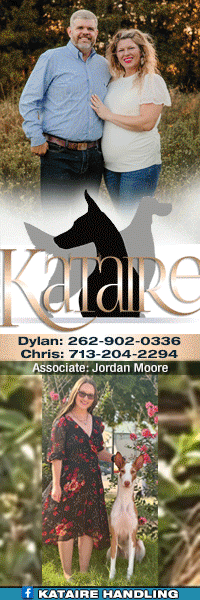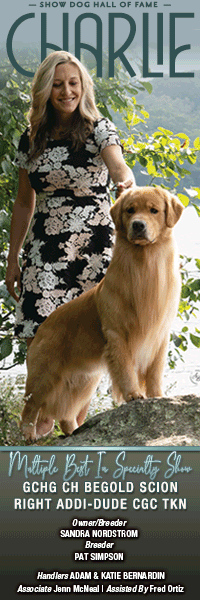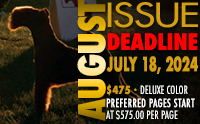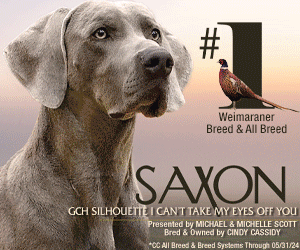Do You See What I See? – Mobility And Know-How
From the archives of The Canine Chronicle, April, 2014
Click here to read the full article in our digital edition.
By Carmen L. Battaglia
 Those who judge know that faults and virtues vary in their degree of severity and in the frequency of their occurrence from dog to dog and from breed to breed. Because virtues and faults occur in all breeds the challenge is to recognize the average dog from the better and the best ones. Generally speaking, it all begins with knowing the breed standard, how to interpret it and being able to recognize what correct and incorrect structure looks like when standing and in motion. Since most dogs are nearly average in quality, evaluating them requires an understanding of anatomy and the principles of good movement. Said another way, many faults and virtues can be seen by observing a dog standing but only in motion can other traits and faults be revealed.
Those who judge know that faults and virtues vary in their degree of severity and in the frequency of their occurrence from dog to dog and from breed to breed. Because virtues and faults occur in all breeds the challenge is to recognize the average dog from the better and the best ones. Generally speaking, it all begins with knowing the breed standard, how to interpret it and being able to recognize what correct and incorrect structure looks like when standing and in motion. Since most dogs are nearly average in quality, evaluating them requires an understanding of anatomy and the principles of good movement. Said another way, many faults and virtues can be seen by observing a dog standing but only in motion can other traits and faults be revealed.
JUDGES AND STATIONARIES
As a judge, I have learned that the essential elements of evaluation depend on several things. It begins with your proximity to the dog and where you stand throughout the judging process. For example, when dogs are in motion, movement is often quicker than the eye can follow and in the confined space and limited time allowed in the show ring even the educated can be misled. This means that traits can easily be missed. For example, dogs move in different ways at different speeds, therefore, what will be seen at a walk or trot is determined by where you are standing and what you look for during the side gait and the down and back exercise. Those who are outside the ring have many of the same problems as a judge in the ring. The difference is that those outside the ring, for the most part, are less mobile. They sit in a chair or stand in one place throughout the judging. I call this group the “stationaries”. As a group they can be described as those who are likely to miss some of the more obvious problems of structure and movement. Most everyone can see poor movement because of its apparent awkwardness. Poor toplines, pounding, steep shoulders, cow hocks, elbows out, loose shoulders and the east-west fronts are a little more difficult and will be missed if the judge or person at ringside does not move into the right place. This problem occurs for the “stationary” because they usually find one location and watch all of the judging from that spot. They are generally not mobile during the judging process which causes them to miss seeing the down-and-back and some, or the entire, side gait. Only a few at ringside will see the individual examination, the down and back, and the sidegait. Too often the stationary becomes one of the ringside critics.
Being close to each dog during the individual examination makes a difference when looking for breed type (silhouette, head, eyes, coat, and color). If a judge elected to sit in a chair or stand in one location and officiate each class, the quality of evaluations would be unacceptable and no one would respect the final decision. In addition to location and proximity to the dog, it is important to develop an educated eye, one that looks for dogs with fluidity, efficiency, balance and coordination. For the judge, the process is complicated by the time allowed and the fact that not all dogs move alike. Structural variations effect how they put their feet down. For example, the massive Bulldog with its low center of gravity and wide front does not move like the Wolfhound with its long legs and muscular body.
Interpreting breed standards is another issue. All standards discuss general appearance, body proportions, virtues, faults and special traits such as height to length, shoulders and croups. Some describe a breed as “square” which is taken to mean height at the highest point of the withers is equal to the length of the body from the shoulder point to the buttocks or rump. What can complicate seeing a “square” bodied dog or one that is “almost square” or “rectangular” is the color and markings on the body, neck and feet. They can influence appearance of height and length by creating an optical illusion. Markings can make a dog look taller, longer or shorter depending on where the colors, spots and patches are located. For this reason judges will walk around a dog and look at it from both sides.

From the archives of The Canine Chronicle, April, 2014
Click here to read the full article in our digital edition.
Short URL: http://caninechronicle.com/?p=46291
Comments are closed











